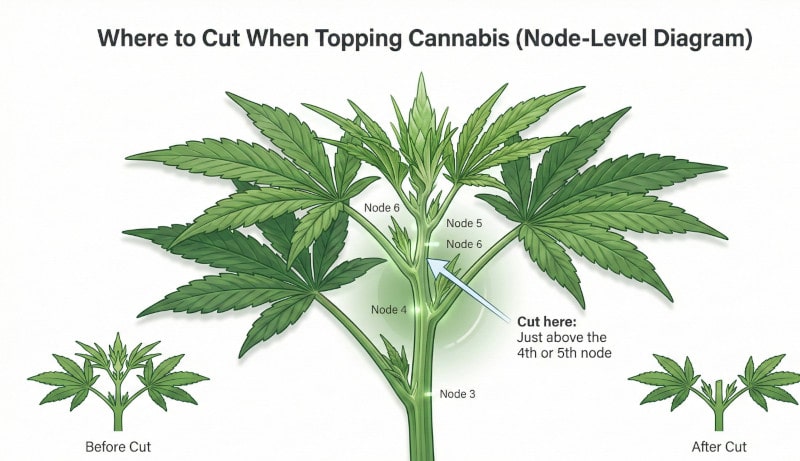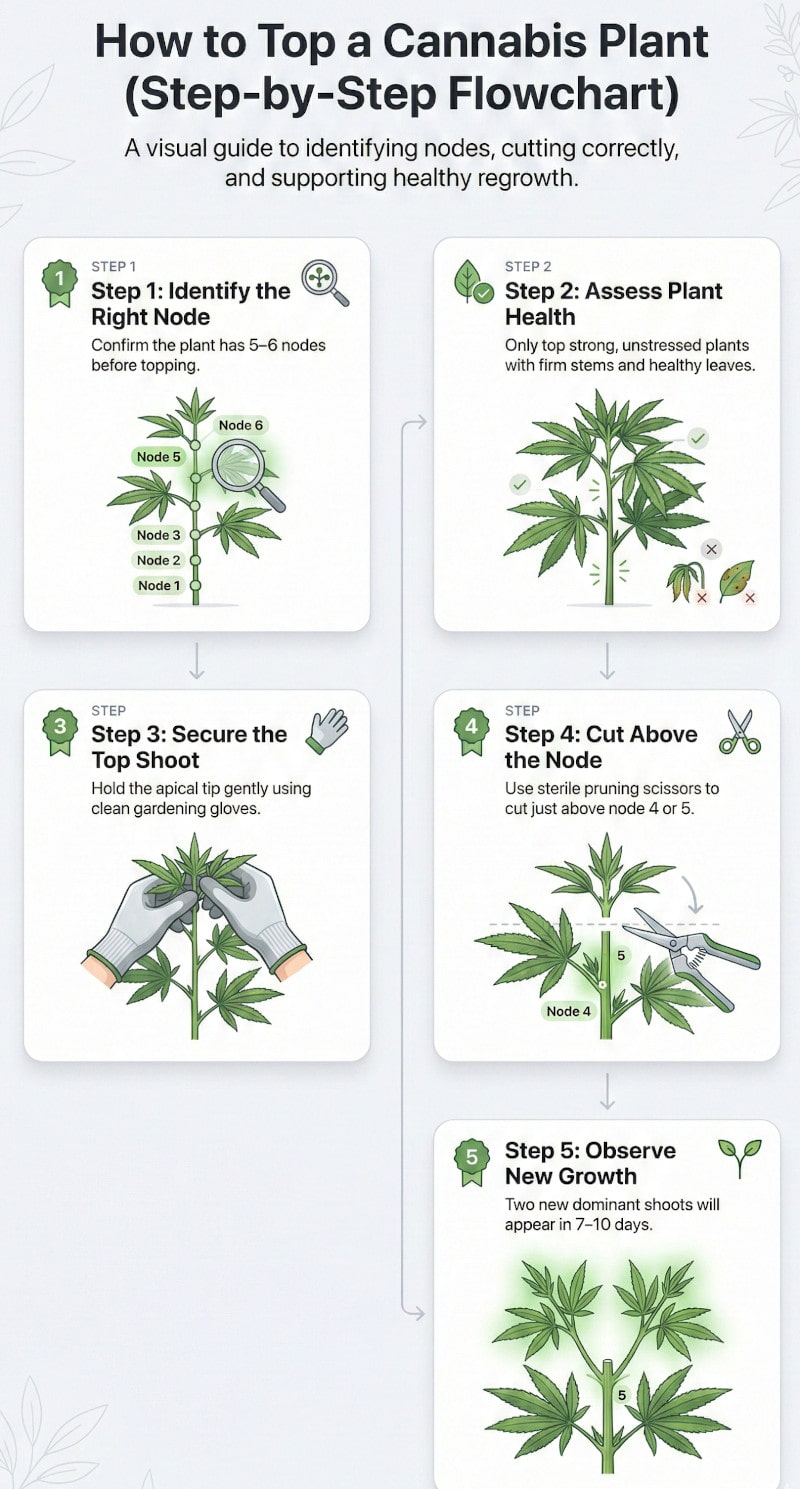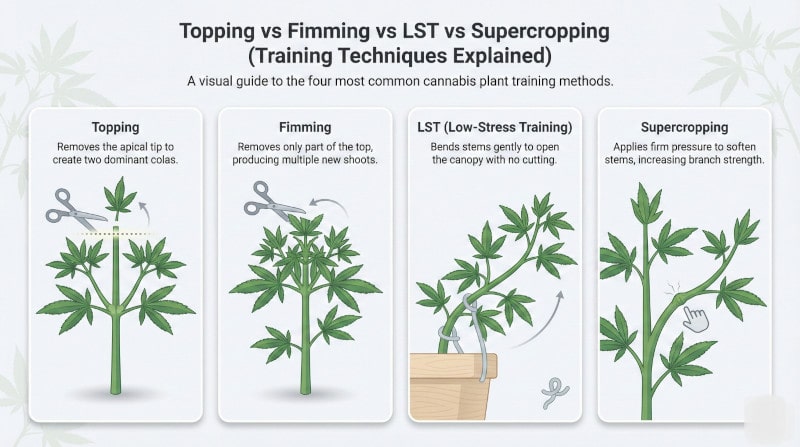Topping Cannabis Plants
Topping Cannabis Plants | Why, When, and How to Top
Updated: November 2025 | Topping your plants - why you should to that
Author: Cannapot Grow Team | Reading time: approximately ten minutes

Topping is one of the most reliable training methods when you want stronger yields and better control over plant height. Growers across Europe have used it for decades, not because it is trendy, but because it works. When done correctly, a topped plant develops more main branches, spreads its canopy naturally, and uses available light more efficiently. This guide explains how topping works, when the timing is right, and what growers should expect during recovery. Before you start topping, you should buy feminized cannabis seeds that are robust and branchy.
What Topping Actually Is
Topping is a high-stress training technique where the grower removes the top growth point of the cannabis plant. The cut interrupts apical dominance. When the apical tip is gone, hormones inside the plant (especially auxins and cytokinins) redistribute toward the lower nodes. This change encourages two new dominant growth shoots instead of one.
A topped plant will not grow taller along a single central stem. Instead, it divides its growth energy into multiple main colas. This is the same principle used in horticulture for shaping fruit trees or controlling the height of vine crops.
Why Growers Use Topping
1. To Increase Yield Potential
A single-stem plant usually produces one main cola and multiple smaller side branches. After topping, the plant can develop two, four, or even more primary colas depending on how many times it is topped. More top-quality flowers mean a stronger final yield.
2. To Improve Light Distribution
A typical indoor setup shines the strongest light at the top of the canopy. Topping lowers and widens the plant structure so more branches receive equal lighting. This reduces popcorn buds and increases the number of fully developed flowers.
3. Another reason growers top their plants is simple space control
In tents or tight spots, plants tend to shoot upward fast, and that extra stretch becomes hard to manage. By cutting the top early, the plant grows more outward than upward, which keeps the height easier to handle, especially when the lights can’t be raised any higher.
4. To Create a Stable Canopy for SCROG
If you plan to grow in a screen-of-green setup, topping is almost essential. A plant with multiple main branches fills the net evenly and grows at the same pace across the screen.
When To Top Cannabis Plants

Timing determines whether topping helps or harms your grow. The plant must be healthy, strong, and developmentally ready.
Node Count: The Most Reliable Method
Most growers top between the 5th and 7th node. At this stage:
-
The stem is thick enough
-
The root system is established
-
The plant can absorb stress without slowing down growth
Anything before the 4th node increases risk of stunting or deforming the plant.
Plant Age
Most photoperiod plants can be topped when they are 3–5 weeks old. Growth speed varies by strain, temperature, and pot size. Age is less important than overall structure.
Signs Your Plant Is Not Ready to Be Topped
Avoid topping if:
-
The leaves are pale
-
The plant looks droopy
-
The stem is still thin or purple
-
The plant is recovering from overwatering or nutrient imbalance
-
The plant was recently transplanted
A stressed plant will take much longer to recover and may not produce symmetrical regrowth.
How To Top Cannabis Plants (Step-by-Step)

1. Choose the Correct Tools
Use clean, sharp scissors or pruning shears. A smooth cut helps the plant heal faster. Disinfect the tool before use.
2. Identify the Top Node
Locate the newest growth point at the very top. The cut should be made just above the node you want to keep. Most growers leave the 4th or 5th node intact and remove everything above it.
3. Make a Clean Cut
Use your fingers to hold the new tip in place so it doesn’t wobble, then snip it off with a simple, clean cut. Do not crush the stem. The goal is to remove the apical tip without damaging the lower nodes.
4. Monitor the Plant Over the Next 48 Hours
In the two days, the plant redirects energy into the two topmost nodes below the cut. These will slowly form two new leading shoots.
5. Recovery Phase (7–14 Days)
During recovery:
-
Keep light intensity stable
-
Maintain a steady environment
-
Avoid giving too many nutrients
-
Do not combine topping with heavy defoliation
A slow response is normal. After the first week, growth usually accelerates and the canopy begins to widen.
Indoor vs Outdoor Topping Strategies
Indoor Growing
Indoor plants generally receive more controlled lighting and airflow, which allows for multiple toppings if growth is strong. Most indoor growers top once or twice to maintain a flat, even canopy. Indoor topping is often combined with low-stress training to spread branches horizontally.
Outdoor Growing
Outdoor plants grow larger and have more vertical space. Many growers top outdoor plants two or three times, especially if they want heavy branching or need to prevent tall visible plants. The sun naturally reaches multiple angles, so a wide structure offers significant advantages.
Outdoor plants tolerate topping well, but wind stress must be considered. Thick stems develop naturally over time, which helps support multiple branches.
Which Strains Respond Best to Topping
Feminized Photoperiod Strains
Most feminized photoperiod seeds respond well to topping. Indica-dominant hybrids usually show quick lateral growth. Sativa-dominant strains also react strongly but may stretch more afterward.
Autoflower Strains
Topping autos is possible, but only if:
-
The plant grows very fast
-
The genetics are robust
-
The topping happens early (day 14–20 from germination)
Most growers avoid topping autoflowers because a short vegetative phase gives little time for recovery. Gentle LST is usually safer.
Landrace or Wild Genetics
Some landrace sativas, especially tropical varieties, recover slowly. They should be topped only once or trained with softer methods.
Topping vs Fimming vs LST vs Supercropping

|
Technique |
Stress Level |
Purpose |
Best For |
|
Topping |
High |
Creates two main colas |
Most photoperiod strains |
|
Fimming |
Medium |
Produces 3–6 new shoots |
Fast-growing hybrid strains |
|
LST |
Low |
Opens canopy without cutting |
Autoflowers, sensitive strains |
|
Supercropping |
High |
Strengthens branches via bending |
Experienced growers |
This comparison helps beginners decide whether topping is the correct method for their space and strain.
Common Mistakes to Avoid
-
Topping too early
Plants topped before the 4th node often become stunted. -
Topping unhealthy plants
Any plant under stress will recover slowly and may produce uneven branching. -
Combining topping with taking off extra leaves
Too much stress in a short period prolongs recovery.
-
Poor light positioning after topping
-
Topping during early flowering
Once the plant shifts into bloom, topping is no longer beneficial and delays flower development.
How Often Can You Top?
Most growers top their plants one or two times. The plant must fully recover before any second topping. Additional toppings extend vegetative growth, which is fine for indoor growers who want dense SCROG setups. Outdoor growers sometimes top three times, depending on local climate and season length.
Aftercare: Helping the Plant Recover Smoothly
1. Light
Keep light levels steady. Avoid sudden increases in intensity. A moderate level supports healing.
2. Temperature and Humidity
Stable conditions are more important than perfect numbers. Sudden humidity drops can slow recovery.
3. Watering
Do not overwater. A topped plant with slow metabolism uses less moisture for a few days.
4. Nutrients
A mild, balanced feed is enough. Avoid strong nitrogen spikes, which may cause thin stretching.
5. Training After Topping
Once new shoots reach several centimeters in length, they can be gently guided outward using soft plant ties.
FAQs
Q: Does topping increase yields?
A: Yes, topping increases potential yield because it creates multiple main colas that receive equal light exposure.
Q: Should beginners top their first plant?
A: Most photoperiod plants can be topped safely. It is one of the simplest training methods for new growers.
Q: Can I top autoflowers?
A: Only if the plant shows very fast early growth. Otherwise, LST is safer.
Q: How long should I wait after topping before training?
A: Most growers wait one week. The new shoots should be strong enough to handle gentle bending.
Q: Should I top a plant that is stretching?
A: Yes. Topping helps control vertical stretch and encourages outward growth.
